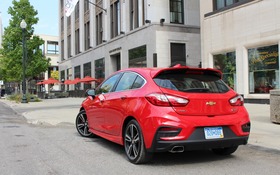Chevrolet Cruze: no Performance Model on the Horizon
At the recent 2017 Chevrolet Cruze Hatch media drive, I asked Alan S Batey, GM’s Executive Vice President and President, North America, why the company decided to offer a turbo-diesel powertrain in the compact Cruze when the general U.S. consumer doesn’t care all that much about diesels. His answer could’ve been simpler: “we’re already building the engine in Europe, might as well offer it the U.S. and Canada.”
Makes sense. It’s not like they invested millions to develop it specifically for North America. The worse that can happen is that people don’t buy it. Really not a big deal, and we can’t blame Chevrolet for trying to lure Golf buyers away from Volkswagen.

So with the redesigned sedan, the new 2017 Chevrolet Cruze Hatch, two very different engine choices and the option of manual and automatic transmissions, GM has a model that offers something for many people. Except a performance model, that is.
There are no immediate plans to create a rival to the Volkswagen Golf GTI, the Ford Focus ST, the Honda Civic Si, the Subaru WRX, the Kia Forte SX and the Hyundai Elantra Sport. You know, a version of the Cruze with an engine output in the 200-to-250-horsepower range, a sport-tuned suspension, a more direct steering system and racy alloy wheels for extra street cred.
We are aware that a slim proportion of compact-car buyers actually go for these performance versions, as they cost in the $27K to $35K price range. Yet a sportier Cruze would get some attention from a younger clientele. The same people who can’t necessarily afford a GTI, but settle for a Golf thinking “it’s nearly a GTI.”
I remember back when I was a teenager, in the Eighties. Our affordable dream cars included the Honda Civic Si and CRX, the Volkswagen Golf GTI, the Acura Integra, the Mitsubishi Eclipse and Plymouth Laser, the Honda Prelude and the Mazda MX-6, among others. General Motors’ adversary to these mostly Japanese cars was the Chevrolet Cavalier Z24. It was different because it was equipped with a 2.8-litre V6 while its rivals mostly had four-cylinder power, some with turbos. Z24s were very popular back then and stood out from the crowd with its aerodynamic add-ons and two-tone exterior presentation. It was even offered as a convertible.
The third generation of the Cavalier, introduced in 1995, downgraded the Z24 to four-cylinder engines, and although they were about as powerful as the old V6, the sound and the torque wasn’t the same. The Cobalt, which replaced the Cavalier in 2004, was available in SS trim, and its options list included either a supercharged 2.0-litre four or a turbo engine of the same displacement. With up to 260 hp and 260 lb.-ft. of torque, the Cobalt was an interesting and affordable little muscle car.
It’s time for GM to whip up a performance-oriented Cruze using the turbocharged, 2.0-litre four that’s available in the Camaro and the Malibu. We don’t know if this engine would fit in the Cruze’s engine bay, but if it did, to quote Mr. Batey, they’re already building it, so they might as well offer it. Would you be interested in a 250-hp Cruze SS?












